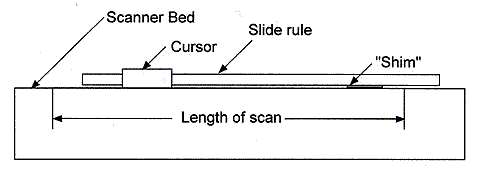 Scanner Setup
Scanner SetupThe simplest way to create a scan of a ten inch rule would be to
simply lay it on the scan bed and scan two times, taking left and
right halves separately and combining the two later. But this will
result in uneven brightness of the slide rule surfaces because,
due to the presence of a cursor, the distance from the scanning
bed to the slide rule surface of one scan is different from the
other scan. Because of this uneven brightness, it is extremely difficult
to "seamlessly" join two images to form a complete image
of a rule.
To avoid this problem I decided to raise the "non-cursor" end with
"shim" as shown in the above illustration.
After taking the first scan. the rule is is moved to left so that
the right end is within the scanning range. The shim is moved further
to the left so that, when splicing, the shim can be cut out.
Scan resolution: I use 300
DPI (dot per inch) for all the rules. It gives enough fineness
to read detail of the rule.
Alignment: I align the rule roughly by eyeballing.
Images can be squared a the later editing phase.
|